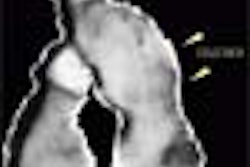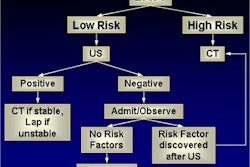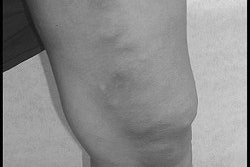PHILADELPHIA - Ultrasound should be the gold standard for diagnosing cystic liver masses, according to a presentation at the Leading Edge in Diagnostic Ultrasound meeting this week. Moreover, ultrasound-guided percutaneous treatment of such lesions has proven to be safe and effective, said Dr. Malkhaz Mizandari of the Ultrasound Education Center at Tbilisi State Medical University in the Republic of Georgia.
Mizandari presented the research during an international forum for ultrasound research. The Tbilisi research team studied 105 patients (59 female and 46 male), ranging in age from 21 to 76. Amebic abscess was diagnosed in 42 patients, echinococcal cyst in 36 patients, pyogenic abscess in 14, hematoma in seven, subdiaphragmatic abscess in four, and fungal abscess in two.
Ultrasound was performed in all 105 patients, while 45 patients received CT studies and 18 had MRI. For amebic abscess patients, ultrasound yielded a diagnostic accuracy of 85.6%, while CT and MRI turned in 82.6% and 77.8%, respectively. Ultrasound, MRI, and CT were used for the diagnosis of echinococcal cyst in 83.8%, 71%, and 66.7% of patients, respectively.
In pyogenic abscess cases, ultrasound produced an 87.4% diagnostic accuracy, while CT had 88.8% and MRI 77.8%. Ultrasound had a diagnostic accuracy of 87.4% and CT 92.8%. Only ultrasound was performed in both fungal abscess cases, yielding 86% accuracy.
Ultrasound provided the highest overall diagnostic accuracy in diagnosing amebic abscess, echinococcal cyst, and hematoma, while CT was more informative in cases of pyogenic and subdiaphragmatic abscess, Mizandari said.
"The possibility of percutaneous diagnostic puncture makes ultrasound 100% specific and excludes the necessity of CT or MRI in most cases," he said.
Percutaneous treatment was performed using ultrasound guidance in 53 patients (combined ultrasound-fluoroscopy guidance in 18 cases). Pathologies seen in the 53 patients included amebic abscess (34 cases), pyogenic abscess (10 cases), hematoma (5), and subdiaphragmatic abscess (4).
Ultrasound-guided treatment achieved recovery in 50 cases (94.3%), 42 from the first procedure and eight from a repeated procedure, he said. Two (3.8%) required open surgery, and one patient died. The death was caused by inadequate treatment prior to ultrasound intervention, and was not related to the procedure, Mizandari said.
In one subdiaphragmatic abscess case, the percutaneous drainage procedure was complicated by an intrahepatic hematoma formation. The resulting hematoma was also treated percutaneously using the same drainage catheter, which was inserted under fluoroscopic guidance, Mizandari said.
Based on his research, Mizandari proposed a management algorithm for cystic liver masses. In case of ineffective medical treatment, amebic abscess cases should receive ultrasound-guided aspiration or drainage procedure, he said.
Meanwhile, patients diagnosed with echinococcal cyst from ultrasound should receive the specific immunoferment test. If that test is positive, CT and/or MRI should be given to provide better planning of surgical management, he said.
"In case of negative results, ultrasound-guided fine-needle diagnostic puncture or ultrasound follow-up should be performed," he said.
Ultrasound or combined ultrasound-fluoroscopy-guided percutaneous drainage procedures should be performed on patients diagnosed with pyogenic abscess, subdiaphragmatic abscess, or hematoma. Sonographic diagnosis of fungal abscess requires specific medical treatment with ultrasound follow-up.
Ultrasound-guided puncture is a safe and effective technique for confirming the diagnosis, he said.
"CT and/or MRI should be added to the diagnostic complex in cases where the ultrasound examination is compromised by technical problems due to excess body weight and bowel gas," Mizandari said. "Ultrasound-guided percutaneous low-invasive treatment of cystic liver masses is safe and effective and can replace open surgery in most cases of liver abscesses and hematoma."
By Erik L. RidleyAuntMinnie.com staff writer
May 15, 2003
Related Reading
3-D ultrasound offers reliable assessment of gallbladder, bile ducts, May 5, 2003
Percutaneous radiofrequency ablation may be an option for solid renal masses, April 21, 2003
Islet cell transplantation may replace insulin for diabetes, March 31, 2003
Radio-frequency ablation effective for many renal cell carcinomas, January 29, 2003
US with Levovist spots malignant hepatic lesions, December 24, 2002
Copyright © 2003 AuntMinnie.com




















